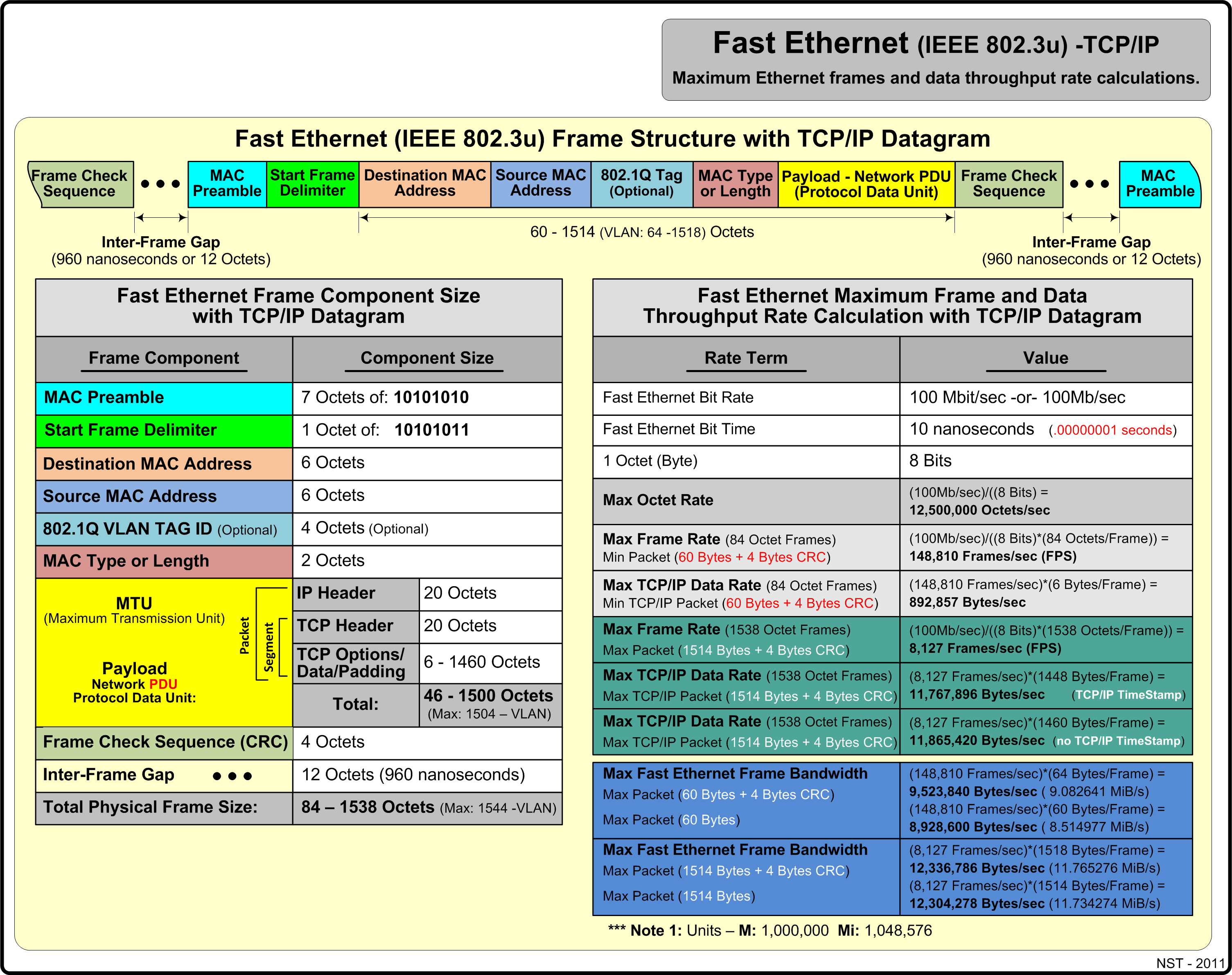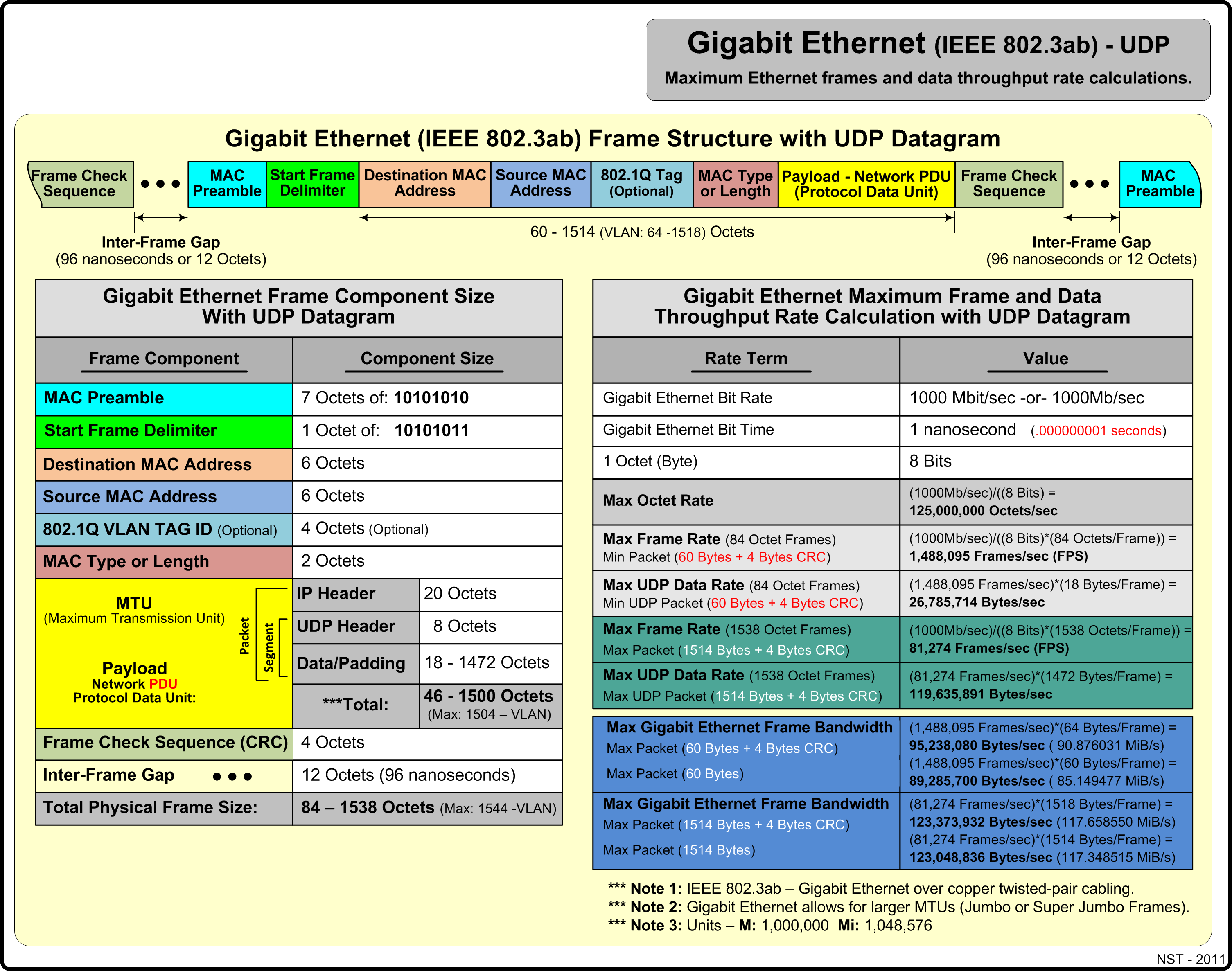Difference between revisions of "LAN Ethernet Maximum Rates, Generation, Capturing & Monitoring"
(→Ethernet Maximum Rates) |
(→Fast Ethernet Using TCP/IP) |
||
| Line 6: | Line 6: | ||
=== Fast Ethernet Using TCP/IP === | === Fast Ethernet Using TCP/IP === | ||
| − | [ | + | It is important to know the maximum and effective data throughput performance and rates when using TCP/IP and UDP network protocols in the LAN. This article will take a stepwise approach in explaining how to determined these rates using various tools found with NST distribution. We will follow many of the methods described in [http://www.ietf.org/rfc/rfc2544.txt RFC 2544 "Benchmarking Methodology for Network Interconnect Devices"] these tasks. |
| − | + | To get started some background information is appropriate. Communication between computer systems using TCP/IP takes place through the exchange of packets. A packet is a PDU (Protocol Data Unit) at the IP layer. The PDU at the TCP layer is called a segment while a PDU at the data-link layer (such as Ethernet) is called a frame. However the term packet is generically used to describe the data unit that is exchanged between TCP/IP layers as well as between two computers. | |
| − | |||
| − | To get started some background information is appropriate. Communication between | ||
First, one needs to know the maximum performance of the network environment to establish a baseline value. I will be using a switched Fast Ethernet (IEEE 802.3u) network configuration. I chose this configuration because it is a common network topology used in today's enterprise internetworking environments. | First, one needs to know the maximum performance of the network environment to establish a baseline value. I will be using a switched Fast Ethernet (IEEE 802.3u) network configuration. I chose this configuration because it is a common network topology used in today's enterprise internetworking environments. | ||
| Line 22: | Line 20: | ||
**Note: Typically protocol analyzers or network monitoring tools do not capture the Ethernet's "Frame Check Sequence" or (Cyclic Redundancy Check (CRC)). The minimum frame length is usually reported as 60 bytes and the maximum length is reported at a 1514 bytes (using the normal Ethernet Maximum Transmission Unit (MTU) = 1500 (RFC 894)). | **Note: Typically protocol analyzers or network monitoring tools do not capture the Ethernet's "Frame Check Sequence" or (Cyclic Redundancy Check (CRC)). The minimum frame length is usually reported as 60 bytes and the maximum length is reported at a 1514 bytes (using the normal Ethernet Maximum Transmission Unit (MTU) = 1500 (RFC 894)). | ||
| + | [[Image:Fast_ethernet_tcpip.png|center|frame|Fast Ethernet (IEEE 802.3u) with TCP/IP maximum rate values.]] | ||
=== Fast Ethernet Using UDP === | === Fast Ethernet Using UDP === | ||
Revision as of 09:54, 17 September 2011
Contents
Overview
This article covers maximum LAN Ethernet rates values that can be achieved for both Fast Ethernet and Gigabit Ethernet using the TCP/IP or the UDP network protocols. The steps on how to generate, capture and monitor maximum Ethernet rates will be shown using various tools bundled with the Network Security Toolkit (NST). Finally, a demonstration on how Linux segmentation off-loading for supported NIC adapters can produce Super Ethernet Frames that are captured and reported by the network protocol analyzer will be presented.
Ethernet Maximum Rates
Fast Ethernet Using TCP/IP
It is important to know the maximum and effective data throughput performance and rates when using TCP/IP and UDP network protocols in the LAN. This article will take a stepwise approach in explaining how to determined these rates using various tools found with NST distribution. We will follow many of the methods described in RFC 2544 "Benchmarking Methodology for Network Interconnect Devices" these tasks.
To get started some background information is appropriate. Communication between computer systems using TCP/IP takes place through the exchange of packets. A packet is a PDU (Protocol Data Unit) at the IP layer. The PDU at the TCP layer is called a segment while a PDU at the data-link layer (such as Ethernet) is called a frame. However the term packet is generically used to describe the data unit that is exchanged between TCP/IP layers as well as between two computers.
First, one needs to know the maximum performance of the network environment to establish a baseline value. I will be using a switched Fast Ethernet (IEEE 802.3u) network configuration. I chose this configuration because it is a common network topology used in today's enterprise internetworking environments.
Frames per second (FPS) or Packets per second (PPS) is a common method of rating the throughput performance of a network device. Understanding how to calculate frames per second can provide a lot of insight on how the Ethernet system functions and assists you in network design.
In this section we will calculate the theoretical maximum frames per second of an Fast Ethernet (100Mb/sec) segment. The calculation is considered theoretical because it requires a network segment without collisions and a standard packet length. Today's network switches allow us to achieve these theoretical limits by providing Full Duplex capability. Also, Ethernet data size relies on the upper layer application, so it is very unlikely to find a stream of packets with exactly the same size in an Ethernet network.
Figure 6.7, “VPN: PPP tunneled over SSH: Fast Ethernet Maximum Throughput Rates” shows the components that make up a Fast Ethernet TCP/IP datagram frame. The minimum frame payload is 46 Bytes (dictated by the slot time of the Ethernet LAN architecture). The maximum frame payload is 1500. The maximum frame rate is achieved by a single transmitting node which does not therefore suffer any collisions. This implies a frame consisting of 72 Bytes with a 960 nanosecond inter-frame gap (corresponding to 12 Bytes at 100Mb/sec).
- Note: Typically protocol analyzers or network monitoring tools do not capture the Ethernet's "Frame Check Sequence" or (Cyclic Redundancy Check (CRC)). The minimum frame length is usually reported as 60 bytes and the maximum length is reported at a 1514 bytes (using the normal Ethernet Maximum Transmission Unit (MTU) = 1500 (RFC 894)).



